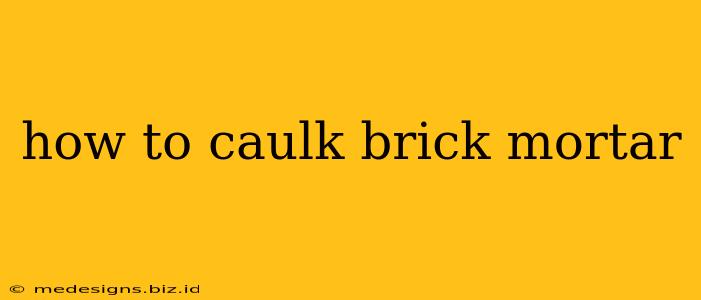Caulking brick mortar is a crucial home maintenance task that prevents water damage, pest infestations, and improves the overall aesthetic appeal of your brickwork. This comprehensive guide will walk you through the process, ensuring you achieve a professional-looking and long-lasting seal.
Preparing for the Caulking Job
Before you even grab your caulk gun, proper preparation is key to a successful caulking project. This stage often gets overlooked, but it's the foundation for a durable and aesthetically pleasing result.
1. Assessing the Damage & Choosing the Right Caulk
Carefully inspect your brickwork to identify all areas needing caulking. Look for cracks, gaps, and deteriorated mortar joints. The size and location of these imperfections will influence your choice of caulk. For exterior brickwork, a high-quality, exterior-grade caulk is essential. This type of caulk is specifically formulated to withstand harsh weather conditions like extreme temperatures, rain, and UV exposure. Consider caulk colors that blend seamlessly with your brick.
2. Cleaning the Mortar Joints
Thoroughly clean the mortar joints you’ll be caulking. Use a wire brush, stiff bristle brush, or even a pressure washer (used cautiously to avoid damaging the brick) to remove loose debris, dirt, and old caulk. This ensures proper adhesion of the new caulk. Removing all loose material is crucial for a successful repair. A clean surface allows for maximum contact between the caulk and the brick, strengthening the seal significantly.
3. Gathering Your Tools and Materials
You'll need the following:
- Exterior-grade caulk: Choose a color that matches your brick as closely as possible.
- Caulk gun: A good quality caulk gun makes application much easier.
- Utility knife or razor blade: For cutting the caulk tube nozzle and cleaning up excess caulk.
- Wire brush or stiff bristle brush: To clean the mortar joints.
- Putty knife or caulk smoothing tool: For smoothing the caulk bead.
- Gloves: To protect your hands.
- Drop cloth or tarp: To protect surrounding surfaces.
- Safety Glasses: Protect your eyes from debris.
Applying the Caulk: A Step-by-Step Guide
Now, let's get to the actual caulking. Follow these steps for a neat and effective seal.
1. Cutting the Caulk Nozzle
Cut the nozzle of the caulk tube at a 45-degree angle. This will give you a consistent bead of caulk that's easy to apply. The size of the cut will determine the width of the bead; adjust accordingly based on the size of the gap you are filling. A smaller cut creates a thinner bead, while a larger cut produces a wider one.
2. Applying the Caulk
Holding the caulk gun at a consistent angle, apply a continuous bead of caulk into the mortar joints. Maintain even pressure to ensure a uniform bead. Work in small sections for better control. Don't overfill the joints – a slightly concave bead is ideal.
3. Smoothing the Caulk
Immediately after applying the caulk, use a putty knife or a specialized caulk smoothing tool to smooth the bead. This will create a professional-looking finish and prevent cracking. Wet your finger (or the smoothing tool) slightly to help smooth the caulk for an even more seamless finish.
4. Cleaning Up
Once the caulk is smooth, use a damp cloth or sponge to clean up any excess caulk. Work quickly before the caulk dries. A razor blade can help remove any stubborn caulk from the brick.
Maintaining Your Caulked Brickwork
After the caulk has fully cured (check the manufacturer's instructions for curing time), inspect your work. Regularly inspect your caulked areas, especially after harsh weather. Recaulking may be needed every few years, depending on the weather conditions and the quality of the caulk used. Addressing minor issues promptly will prevent larger, more costly problems down the line.
By following these steps, you can successfully caulk your brick mortar, protecting your home and enhancing its curb appeal. Remember, preparation and attention to detail are key to achieving a long-lasting and professional-looking result.
